Business Resources, Finance, and Employability Skills Report
VerifiedAdded on 2020/07/22
|10
|2987
|27
Report
AI Summary
This report provides an overview of business resources, focusing on the recruitment and selection process within Tesco. It details job descriptions, required employability, personal, and communication skills. The report explores physical and technological resources, sources of internal and external finance, and the contents of trading, profit and loss accounts, and balance sheets. Additionally, it examines the use of budgets for financial control and analyzes the financial state of a given business. The report covers various aspects of business operations and financial management, using Tesco as a case study to illustrate key concepts and practices.
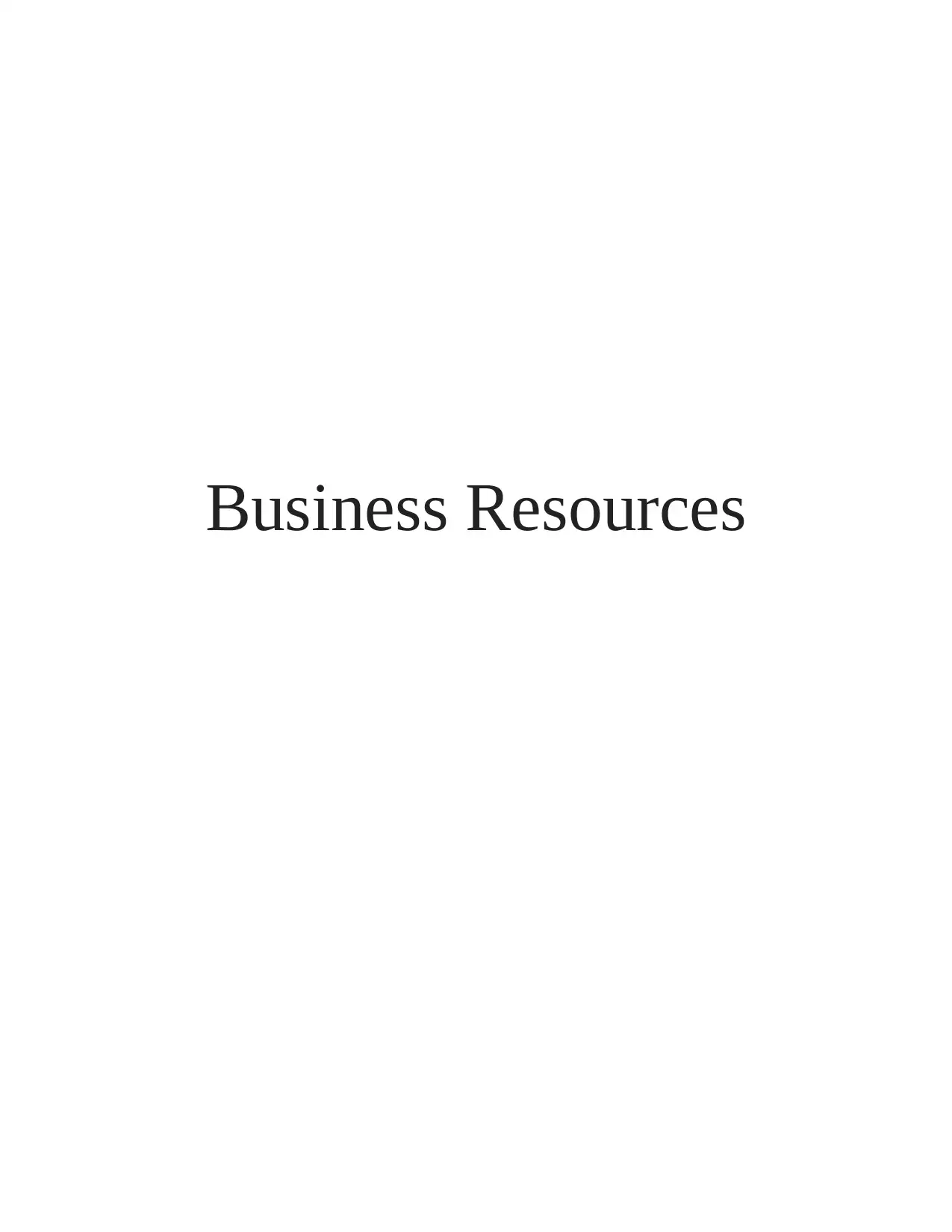
Business Resources
Paraphrase This Document
Need a fresh take? Get an instant paraphrase of this document with our AI Paraphraser
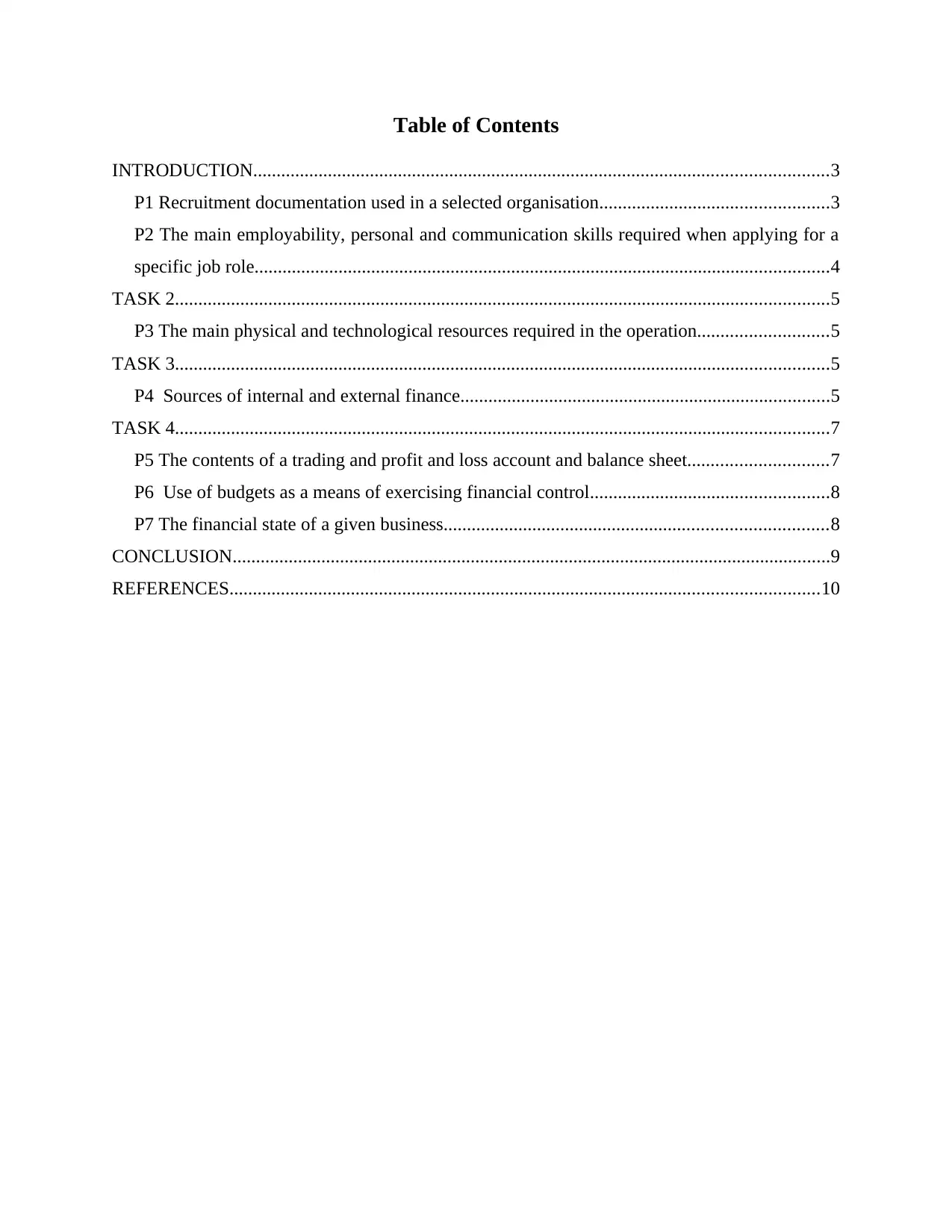
Table of Contents
INTRODUCTION...........................................................................................................................3
P1 Recruitment documentation used in a selected organisation.................................................3
P2 The main employability, personal and communication skills required when applying for a
specific job role...........................................................................................................................4
TASK 2............................................................................................................................................5
P3 The main physical and technological resources required in the operation............................5
TASK 3............................................................................................................................................5
P4 Sources of internal and external finance...............................................................................5
TASK 4............................................................................................................................................7
P5 The contents of a trading and profit and loss account and balance sheet..............................7
P6 Use of budgets as a means of exercising financial control...................................................8
P7 The financial state of a given business..................................................................................8
CONCLUSION................................................................................................................................9
REFERENCES..............................................................................................................................10
INTRODUCTION...........................................................................................................................3
P1 Recruitment documentation used in a selected organisation.................................................3
P2 The main employability, personal and communication skills required when applying for a
specific job role...........................................................................................................................4
TASK 2............................................................................................................................................5
P3 The main physical and technological resources required in the operation............................5
TASK 3............................................................................................................................................5
P4 Sources of internal and external finance...............................................................................5
TASK 4............................................................................................................................................7
P5 The contents of a trading and profit and loss account and balance sheet..............................7
P6 Use of budgets as a means of exercising financial control...................................................8
P7 The financial state of a given business..................................................................................8
CONCLUSION................................................................................................................................9
REFERENCES..............................................................................................................................10
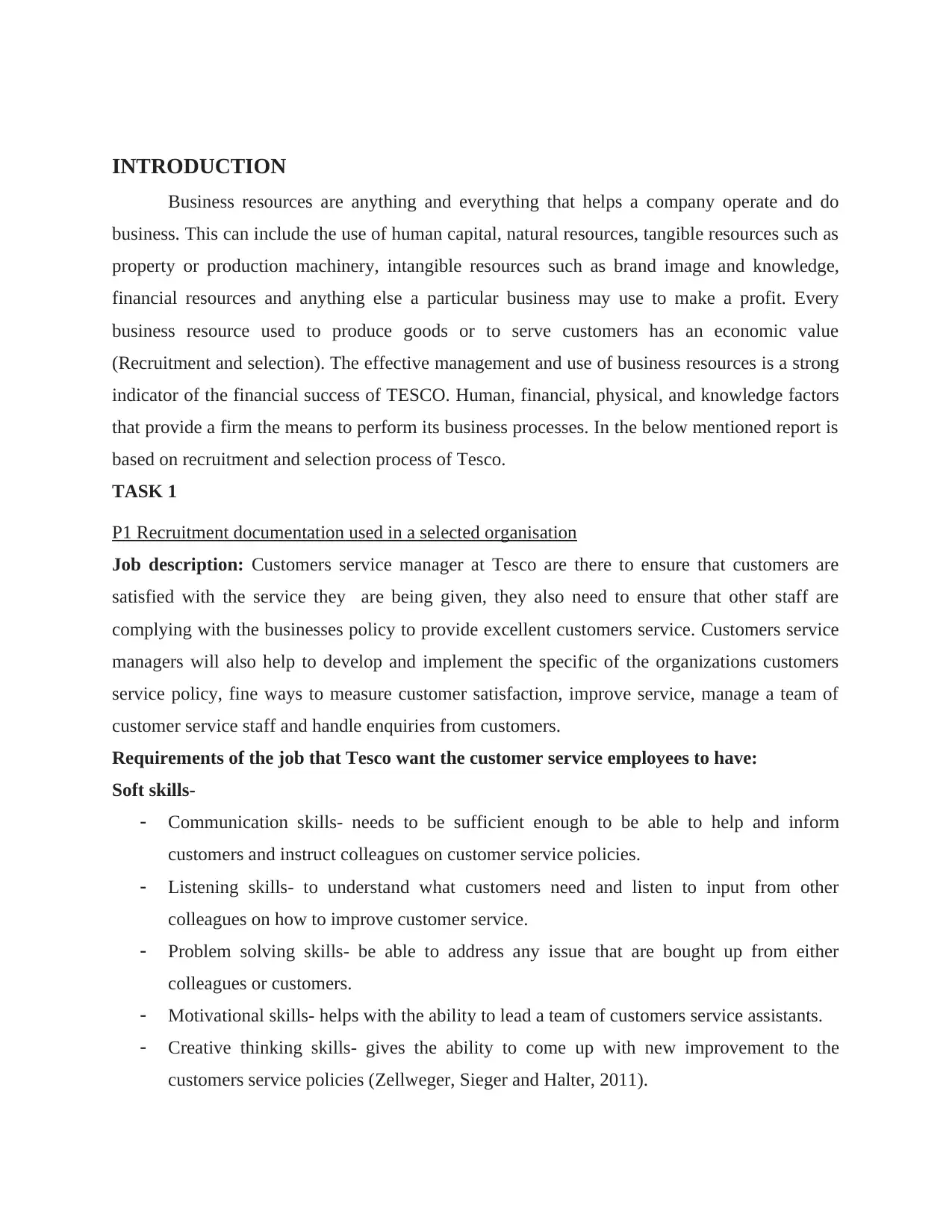
INTRODUCTION
Business resources are anything and everything that helps a company operate and do
business. This can include the use of human capital, natural resources, tangible resources such as
property or production machinery, intangible resources such as brand image and knowledge,
financial resources and anything else a particular business may use to make a profit. Every
business resource used to produce goods or to serve customers has an economic value
(Recruitment and selection). The effective management and use of business resources is a strong
indicator of the financial success of TESCO. Human, financial, physical, and knowledge factors
that provide a firm the means to perform its business processes. In the below mentioned report is
based on recruitment and selection process of Tesco.
TASK 1
P1 Recruitment documentation used in a selected organisation
Job description: Customers service manager at Tesco are there to ensure that customers are
satisfied with the service they are being given, they also need to ensure that other staff are
complying with the businesses policy to provide excellent customers service. Customers service
managers will also help to develop and implement the specific of the organizations customers
service policy, fine ways to measure customer satisfaction, improve service, manage a team of
customer service staff and handle enquiries from customers.
Requirements of the job that Tesco want the customer service employees to have:
Soft skills-
Communication skills- needs to be sufficient enough to be able to help and inform
customers and instruct colleagues on customer service policies.
Listening skills- to understand what customers need and listen to input from other
colleagues on how to improve customer service.
Problem solving skills- be able to address any issue that are bought up from either
colleagues or customers.
Motivational skills- helps with the ability to lead a team of customers service assistants.
Creative thinking skills- gives the ability to come up with new improvement to the
customers service policies (Zellweger, Sieger and Halter, 2011).
Business resources are anything and everything that helps a company operate and do
business. This can include the use of human capital, natural resources, tangible resources such as
property or production machinery, intangible resources such as brand image and knowledge,
financial resources and anything else a particular business may use to make a profit. Every
business resource used to produce goods or to serve customers has an economic value
(Recruitment and selection). The effective management and use of business resources is a strong
indicator of the financial success of TESCO. Human, financial, physical, and knowledge factors
that provide a firm the means to perform its business processes. In the below mentioned report is
based on recruitment and selection process of Tesco.
TASK 1
P1 Recruitment documentation used in a selected organisation
Job description: Customers service manager at Tesco are there to ensure that customers are
satisfied with the service they are being given, they also need to ensure that other staff are
complying with the businesses policy to provide excellent customers service. Customers service
managers will also help to develop and implement the specific of the organizations customers
service policy, fine ways to measure customer satisfaction, improve service, manage a team of
customer service staff and handle enquiries from customers.
Requirements of the job that Tesco want the customer service employees to have:
Soft skills-
Communication skills- needs to be sufficient enough to be able to help and inform
customers and instruct colleagues on customer service policies.
Listening skills- to understand what customers need and listen to input from other
colleagues on how to improve customer service.
Problem solving skills- be able to address any issue that are bought up from either
colleagues or customers.
Motivational skills- helps with the ability to lead a team of customers service assistants.
Creative thinking skills- gives the ability to come up with new improvement to the
customers service policies (Zellweger, Sieger and Halter, 2011).
⊘ This is a preview!⊘
Do you want full access?
Subscribe today to unlock all pages.

Trusted by 1+ million students worldwide
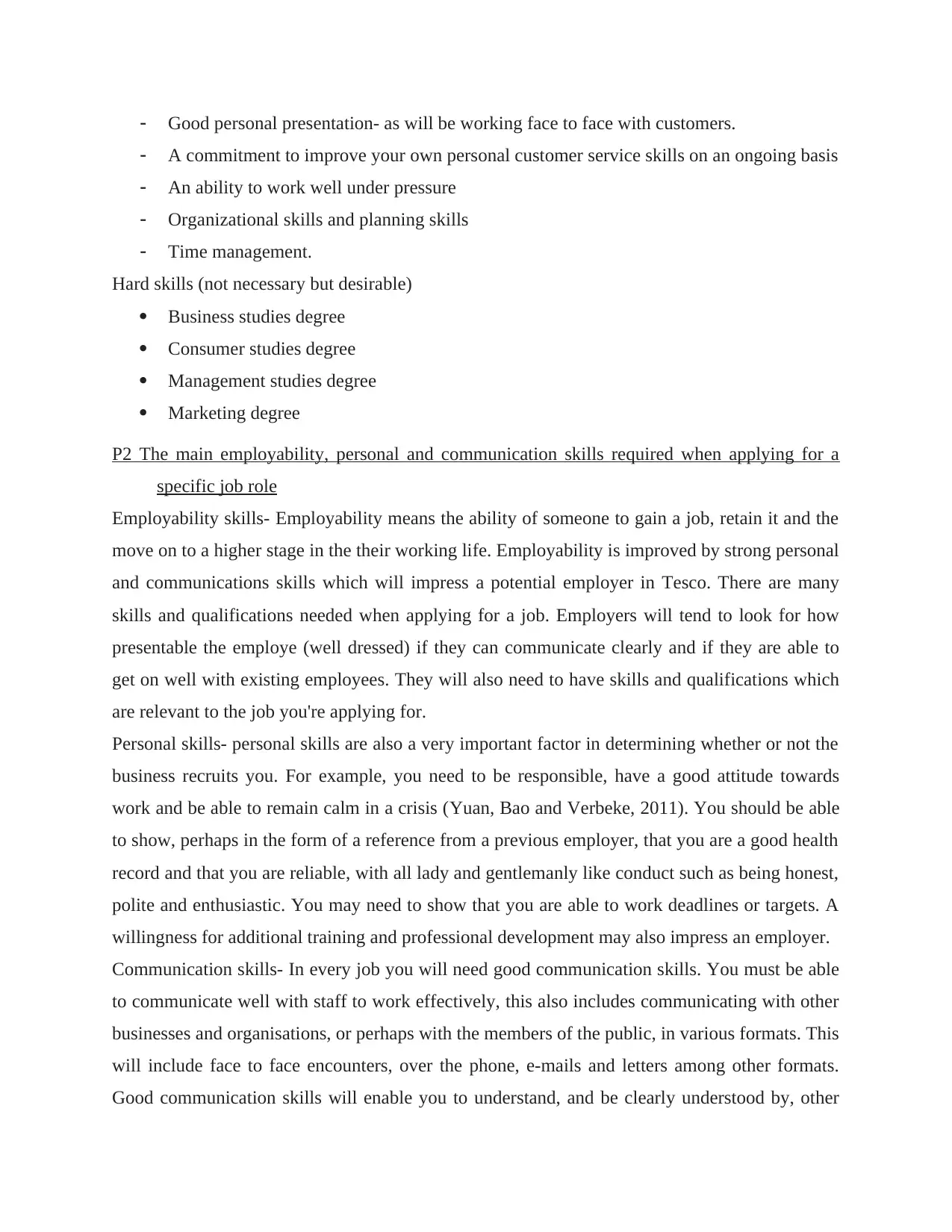
Good personal presentation- as will be working face to face with customers.
A commitment to improve your own personal customer service skills on an ongoing basis
An ability to work well under pressure
Organizational skills and planning skills
Time management.
Hard skills (not necessary but desirable)
Business studies degree
Consumer studies degree
Management studies degree
Marketing degree
P2 The main employability, personal and communication skills required when applying for a
specific job role
Employability skills- Employability means the ability of someone to gain a job, retain it and the
move on to a higher stage in the their working life. Employability is improved by strong personal
and communications skills which will impress a potential employer in Tesco. There are many
skills and qualifications needed when applying for a job. Employers will tend to look for how
presentable the employe (well dressed) if they can communicate clearly and if they are able to
get on well with existing employees. They will also need to have skills and qualifications which
are relevant to the job you're applying for.
Personal skills- personal skills are also a very important factor in determining whether or not the
business recruits you. For example, you need to be responsible, have a good attitude towards
work and be able to remain calm in a crisis (Yuan, Bao and Verbeke, 2011). You should be able
to show, perhaps in the form of a reference from a previous employer, that you are a good health
record and that you are reliable, with all lady and gentlemanly like conduct such as being honest,
polite and enthusiastic. You may need to show that you are able to work deadlines or targets. A
willingness for additional training and professional development may also impress an employer.
Communication skills- In every job you will need good communication skills. You must be able
to communicate well with staff to work effectively, this also includes communicating with other
businesses and organisations, or perhaps with the members of the public, in various formats. This
will include face to face encounters, over the phone, e-mails and letters among other formats.
Good communication skills will enable you to understand, and be clearly understood by, other
A commitment to improve your own personal customer service skills on an ongoing basis
An ability to work well under pressure
Organizational skills and planning skills
Time management.
Hard skills (not necessary but desirable)
Business studies degree
Consumer studies degree
Management studies degree
Marketing degree
P2 The main employability, personal and communication skills required when applying for a
specific job role
Employability skills- Employability means the ability of someone to gain a job, retain it and the
move on to a higher stage in the their working life. Employability is improved by strong personal
and communications skills which will impress a potential employer in Tesco. There are many
skills and qualifications needed when applying for a job. Employers will tend to look for how
presentable the employe (well dressed) if they can communicate clearly and if they are able to
get on well with existing employees. They will also need to have skills and qualifications which
are relevant to the job you're applying for.
Personal skills- personal skills are also a very important factor in determining whether or not the
business recruits you. For example, you need to be responsible, have a good attitude towards
work and be able to remain calm in a crisis (Yuan, Bao and Verbeke, 2011). You should be able
to show, perhaps in the form of a reference from a previous employer, that you are a good health
record and that you are reliable, with all lady and gentlemanly like conduct such as being honest,
polite and enthusiastic. You may need to show that you are able to work deadlines or targets. A
willingness for additional training and professional development may also impress an employer.
Communication skills- In every job you will need good communication skills. You must be able
to communicate well with staff to work effectively, this also includes communicating with other
businesses and organisations, or perhaps with the members of the public, in various formats. This
will include face to face encounters, over the phone, e-mails and letters among other formats.
Good communication skills will enable you to understand, and be clearly understood by, other
Paraphrase This Document
Need a fresh take? Get an instant paraphrase of this document with our AI Paraphraser
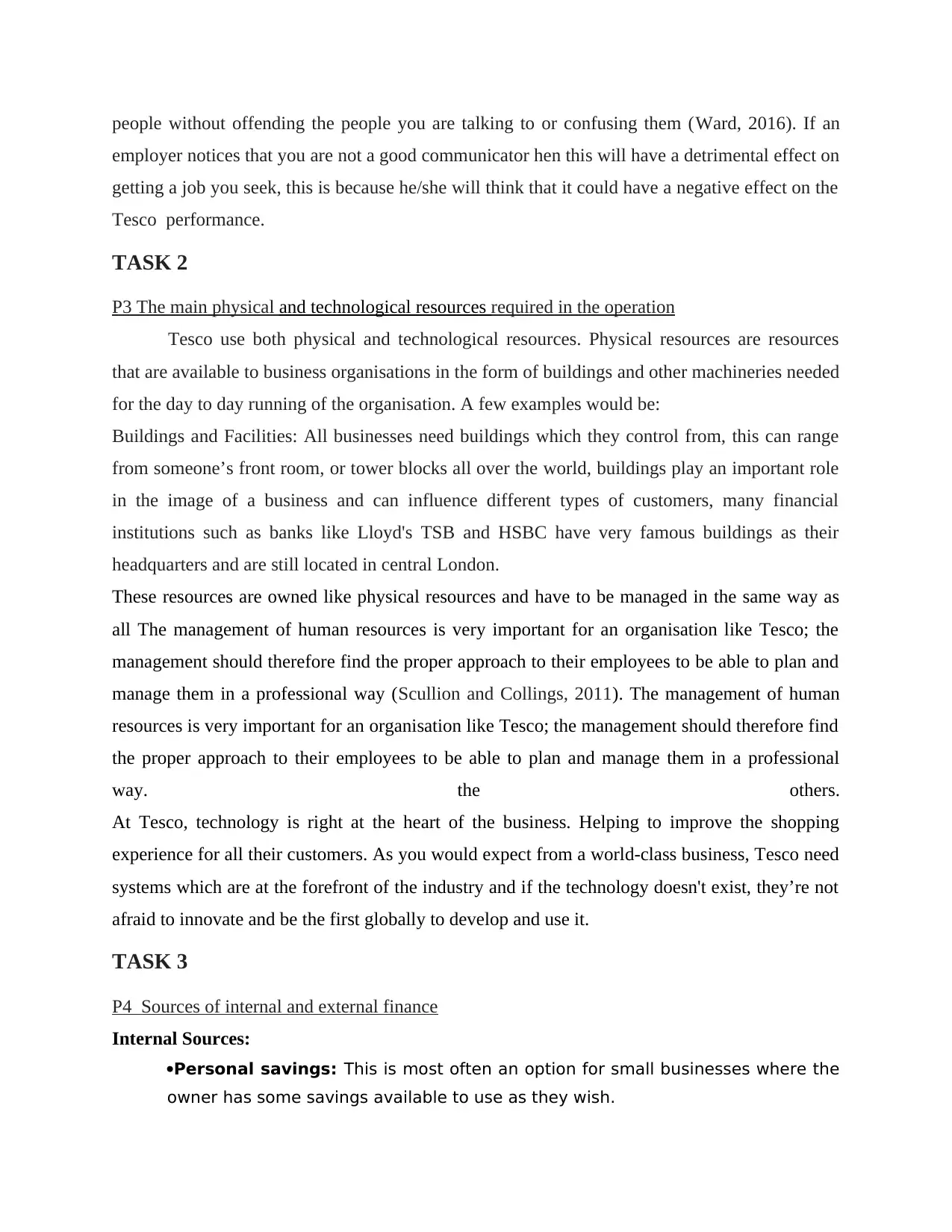
people without offending the people you are talking to or confusing them (Ward, 2016). If an
employer notices that you are not a good communicator hen this will have a detrimental effect on
getting a job you seek, this is because he/she will think that it could have a negative effect on the
Tesco performance.
TASK 2
P3 The main physical and technological resources required in the operation
Tesco use both physical and technological resources. Physical resources are resources
that are available to business organisations in the form of buildings and other machineries needed
for the day to day running of the organisation. A few examples would be:
Buildings and Facilities: All businesses need buildings which they control from, this can range
from someone’s front room, or tower blocks all over the world, buildings play an important role
in the image of a business and can influence different types of customers, many financial
institutions such as banks like Lloyd's TSB and HSBC have very famous buildings as their
headquarters and are still located in central London.
These resources are owned like physical resources and have to be managed in the same way as
all The management of human resources is very important for an organisation like Tesco; the
management should therefore find the proper approach to their employees to be able to plan and
manage them in a professional way (Scullion and Collings, 2011). The management of human
resources is very important for an organisation like Tesco; the management should therefore find
the proper approach to their employees to be able to plan and manage them in a professional
way. the others.
At Tesco, technology is right at the heart of the business. Helping to improve the shopping
experience for all their customers. As you would expect from a world-class business, Tesco need
systems which are at the forefront of the industry and if the technology doesn't exist, they’re not
afraid to innovate and be the first globally to develop and use it.
TASK 3
P4 Sources of internal and external finance
Internal Sources:
Personal savings: This is most often an option for small businesses where the
owner has some savings available to use as they wish.
employer notices that you are not a good communicator hen this will have a detrimental effect on
getting a job you seek, this is because he/she will think that it could have a negative effect on the
Tesco performance.
TASK 2
P3 The main physical and technological resources required in the operation
Tesco use both physical and technological resources. Physical resources are resources
that are available to business organisations in the form of buildings and other machineries needed
for the day to day running of the organisation. A few examples would be:
Buildings and Facilities: All businesses need buildings which they control from, this can range
from someone’s front room, or tower blocks all over the world, buildings play an important role
in the image of a business and can influence different types of customers, many financial
institutions such as banks like Lloyd's TSB and HSBC have very famous buildings as their
headquarters and are still located in central London.
These resources are owned like physical resources and have to be managed in the same way as
all The management of human resources is very important for an organisation like Tesco; the
management should therefore find the proper approach to their employees to be able to plan and
manage them in a professional way (Scullion and Collings, 2011). The management of human
resources is very important for an organisation like Tesco; the management should therefore find
the proper approach to their employees to be able to plan and manage them in a professional
way. the others.
At Tesco, technology is right at the heart of the business. Helping to improve the shopping
experience for all their customers. As you would expect from a world-class business, Tesco need
systems which are at the forefront of the industry and if the technology doesn't exist, they’re not
afraid to innovate and be the first globally to develop and use it.
TASK 3
P4 Sources of internal and external finance
Internal Sources:
Personal savings: This is most often an option for small businesses where the
owner has some savings available to use as they wish.
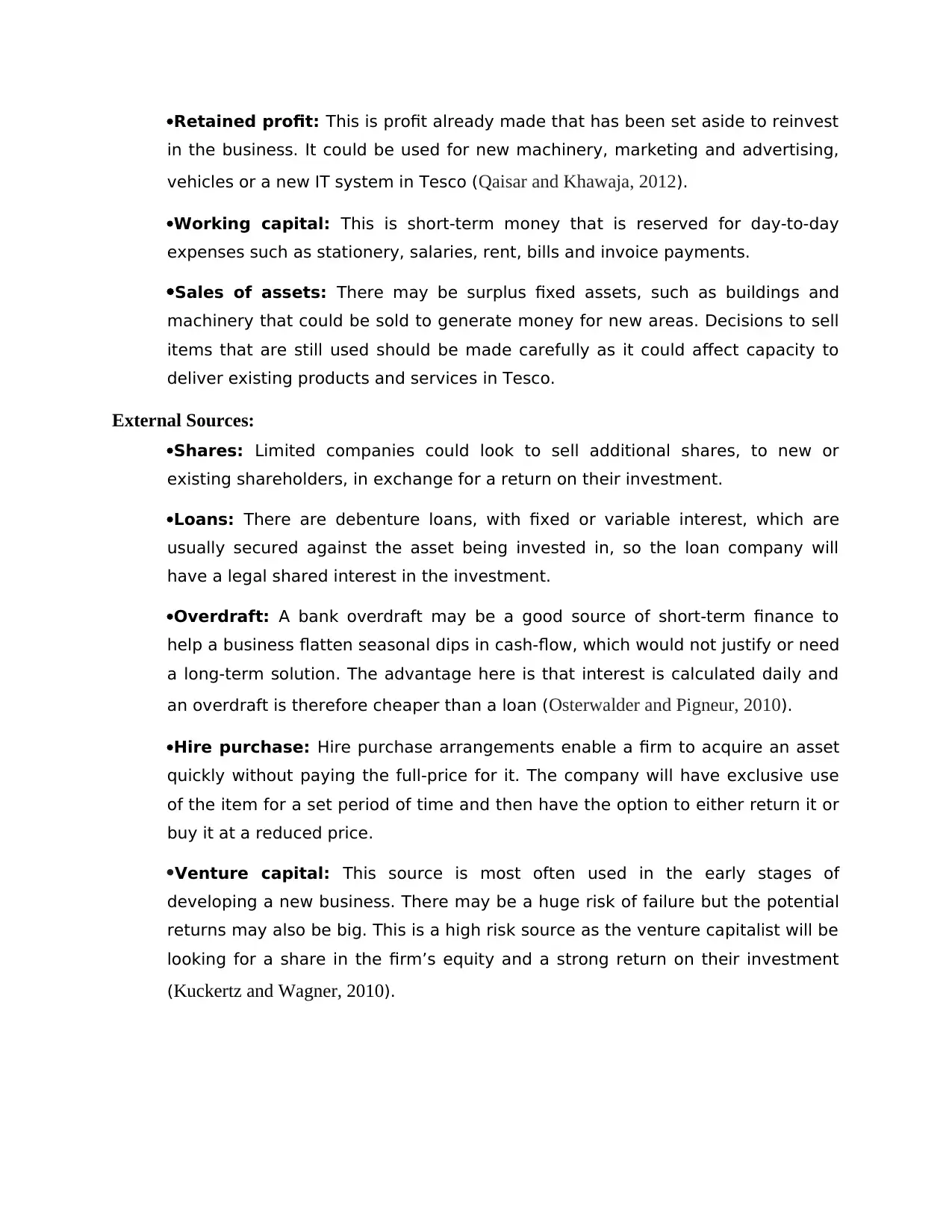
Retained profit: This is profit already made that has been set aside to reinvest
in the business. It could be used for new machinery, marketing and advertising,
vehicles or a new IT system in Tesco (Qaisar and Khawaja, 2012).
Working capital: This is short-term money that is reserved for day-to-day
expenses such as stationery, salaries, rent, bills and invoice payments.
Sales of assets: There may be surplus fixed assets, such as buildings and
machinery that could be sold to generate money for new areas. Decisions to sell
items that are still used should be made carefully as it could affect capacity to
deliver existing products and services in Tesco.
External Sources:
Shares: Limited companies could look to sell additional shares, to new or
existing shareholders, in exchange for a return on their investment.
Loans: There are debenture loans, with fixed or variable interest, which are
usually secured against the asset being invested in, so the loan company will
have a legal shared interest in the investment.
Overdraft: A bank overdraft may be a good source of short-term finance to
help a business flatten seasonal dips in cash-flow, which would not justify or need
a long-term solution. The advantage here is that interest is calculated daily and
an overdraft is therefore cheaper than a loan (Osterwalder and Pigneur, 2010).
Hire purchase: Hire purchase arrangements enable a firm to acquire an asset
quickly without paying the full-price for it. The company will have exclusive use
of the item for a set period of time and then have the option to either return it or
buy it at a reduced price.
Venture capital: This source is most often used in the early stages of
developing a new business. There may be a huge risk of failure but the potential
returns may also be big. This is a high risk source as the venture capitalist will be
looking for a share in the firm’s equity and a strong return on their investment
(Kuckertz and Wagner, 2010).
in the business. It could be used for new machinery, marketing and advertising,
vehicles or a new IT system in Tesco (Qaisar and Khawaja, 2012).
Working capital: This is short-term money that is reserved for day-to-day
expenses such as stationery, salaries, rent, bills and invoice payments.
Sales of assets: There may be surplus fixed assets, such as buildings and
machinery that could be sold to generate money for new areas. Decisions to sell
items that are still used should be made carefully as it could affect capacity to
deliver existing products and services in Tesco.
External Sources:
Shares: Limited companies could look to sell additional shares, to new or
existing shareholders, in exchange for a return on their investment.
Loans: There are debenture loans, with fixed or variable interest, which are
usually secured against the asset being invested in, so the loan company will
have a legal shared interest in the investment.
Overdraft: A bank overdraft may be a good source of short-term finance to
help a business flatten seasonal dips in cash-flow, which would not justify or need
a long-term solution. The advantage here is that interest is calculated daily and
an overdraft is therefore cheaper than a loan (Osterwalder and Pigneur, 2010).
Hire purchase: Hire purchase arrangements enable a firm to acquire an asset
quickly without paying the full-price for it. The company will have exclusive use
of the item for a set period of time and then have the option to either return it or
buy it at a reduced price.
Venture capital: This source is most often used in the early stages of
developing a new business. There may be a huge risk of failure but the potential
returns may also be big. This is a high risk source as the venture capitalist will be
looking for a share in the firm’s equity and a strong return on their investment
(Kuckertz and Wagner, 2010).
⊘ This is a preview!⊘
Do you want full access?
Subscribe today to unlock all pages.

Trusted by 1+ million students worldwide
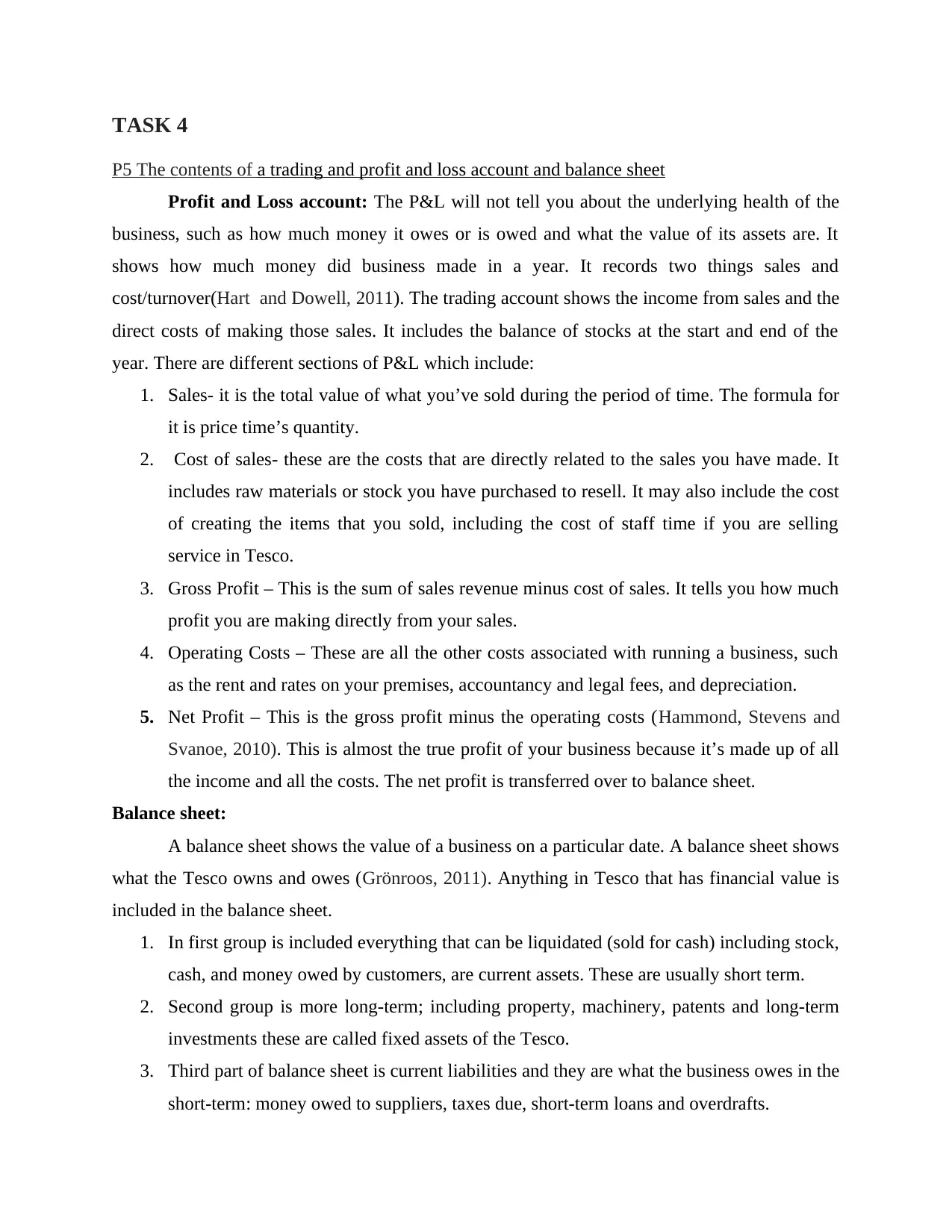
TASK 4
P5 The contents of a trading and profit and loss account and balance sheet
Profit and Loss account: The P&L will not tell you about the underlying health of the
business, such as how much money it owes or is owed and what the value of its assets are. It
shows how much money did business made in a year. It records two things sales and
cost/turnover(Hart and Dowell, 2011). The trading account shows the income from sales and the
direct costs of making those sales. It includes the balance of stocks at the start and end of the
year. There are different sections of P&L which include:
1. Sales- it is the total value of what you’ve sold during the period of time. The formula for
it is price time’s quantity.
2. Cost of sales- these are the costs that are directly related to the sales you have made. It
includes raw materials or stock you have purchased to resell. It may also include the cost
of creating the items that you sold, including the cost of staff time if you are selling
service in Tesco.
3. Gross Profit – This is the sum of sales revenue minus cost of sales. It tells you how much
profit you are making directly from your sales.
4. Operating Costs – These are all the other costs associated with running a business, such
as the rent and rates on your premises, accountancy and legal fees, and depreciation.
5. Net Profit – This is the gross profit minus the operating costs (Hammond, Stevens and
Svanoe, 2010). This is almost the true profit of your business because it’s made up of all
the income and all the costs. The net profit is transferred over to balance sheet.
Balance sheet:
A balance sheet shows the value of a business on a particular date. A balance sheet shows
what the Tesco owns and owes (Grönroos, 2011). Anything in Tesco that has financial value is
included in the balance sheet.
1. In first group is included everything that can be liquidated (sold for cash) including stock,
cash, and money owed by customers, are current assets. These are usually short term.
2. Second group is more long-term; including property, machinery, patents and long-term
investments these are called fixed assets of the Tesco.
3. Third part of balance sheet is current liabilities and they are what the business owes in the
short-term: money owed to suppliers, taxes due, short-term loans and overdrafts.
P5 The contents of a trading and profit and loss account and balance sheet
Profit and Loss account: The P&L will not tell you about the underlying health of the
business, such as how much money it owes or is owed and what the value of its assets are. It
shows how much money did business made in a year. It records two things sales and
cost/turnover(Hart and Dowell, 2011). The trading account shows the income from sales and the
direct costs of making those sales. It includes the balance of stocks at the start and end of the
year. There are different sections of P&L which include:
1. Sales- it is the total value of what you’ve sold during the period of time. The formula for
it is price time’s quantity.
2. Cost of sales- these are the costs that are directly related to the sales you have made. It
includes raw materials or stock you have purchased to resell. It may also include the cost
of creating the items that you sold, including the cost of staff time if you are selling
service in Tesco.
3. Gross Profit – This is the sum of sales revenue minus cost of sales. It tells you how much
profit you are making directly from your sales.
4. Operating Costs – These are all the other costs associated with running a business, such
as the rent and rates on your premises, accountancy and legal fees, and depreciation.
5. Net Profit – This is the gross profit minus the operating costs (Hammond, Stevens and
Svanoe, 2010). This is almost the true profit of your business because it’s made up of all
the income and all the costs. The net profit is transferred over to balance sheet.
Balance sheet:
A balance sheet shows the value of a business on a particular date. A balance sheet shows
what the Tesco owns and owes (Grönroos, 2011). Anything in Tesco that has financial value is
included in the balance sheet.
1. In first group is included everything that can be liquidated (sold for cash) including stock,
cash, and money owed by customers, are current assets. These are usually short term.
2. Second group is more long-term; including property, machinery, patents and long-term
investments these are called fixed assets of the Tesco.
3. Third part of balance sheet is current liabilities and they are what the business owes in the
short-term: money owed to suppliers, taxes due, short-term loans and overdrafts.
Paraphrase This Document
Need a fresh take? Get an instant paraphrase of this document with our AI Paraphraser
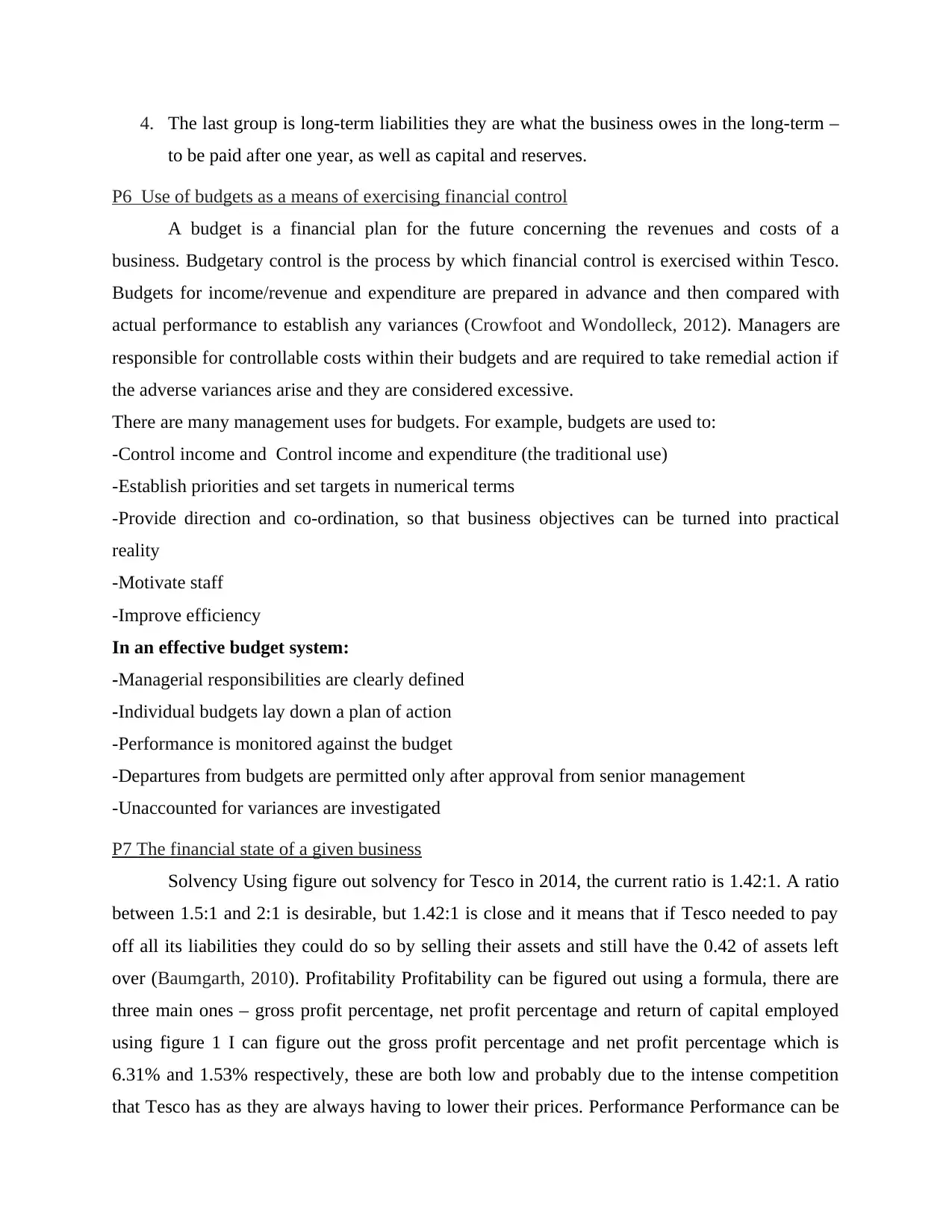
4. The last group is long-term liabilities they are what the business owes in the long-term –
to be paid after one year, as well as capital and reserves.
P6 Use of budgets as a means of exercising financial control
A budget is a financial plan for the future concerning the revenues and costs of a
business. Budgetary control is the process by which financial control is exercised within Tesco.
Budgets for income/revenue and expenditure are prepared in advance and then compared with
actual performance to establish any variances (Crowfoot and Wondolleck, 2012). Managers are
responsible for controllable costs within their budgets and are required to take remedial action if
the adverse variances arise and they are considered excessive.
There are many management uses for budgets. For example, budgets are used to:
-Control income and Control income and expenditure (the traditional use)
-Establish priorities and set targets in numerical terms
-Provide direction and co-ordination, so that business objectives can be turned into practical
reality
-Motivate staff
-Improve efficiency
In an effective budget system:
-Managerial responsibilities are clearly defined
-Individual budgets lay down a plan of action
-Performance is monitored against the budget
-Departures from budgets are permitted only after approval from senior management
-Unaccounted for variances are investigated
P7 The financial state of a given business
Solvency Using figure out solvency for Tesco in 2014, the current ratio is 1.42:1. A ratio
between 1.5:1 and 2:1 is desirable, but 1.42:1 is close and it means that if Tesco needed to pay
off all its liabilities they could do so by selling their assets and still have the 0.42 of assets left
over (Baumgarth, 2010). Profitability Profitability can be figured out using a formula, there are
three main ones – gross profit percentage, net profit percentage and return of capital employed
using figure 1 I can figure out the gross profit percentage and net profit percentage which is
6.31% and 1.53% respectively, these are both low and probably due to the intense competition
that Tesco has as they are always having to lower their prices. Performance Performance can be
to be paid after one year, as well as capital and reserves.
P6 Use of budgets as a means of exercising financial control
A budget is a financial plan for the future concerning the revenues and costs of a
business. Budgetary control is the process by which financial control is exercised within Tesco.
Budgets for income/revenue and expenditure are prepared in advance and then compared with
actual performance to establish any variances (Crowfoot and Wondolleck, 2012). Managers are
responsible for controllable costs within their budgets and are required to take remedial action if
the adverse variances arise and they are considered excessive.
There are many management uses for budgets. For example, budgets are used to:
-Control income and Control income and expenditure (the traditional use)
-Establish priorities and set targets in numerical terms
-Provide direction and co-ordination, so that business objectives can be turned into practical
reality
-Motivate staff
-Improve efficiency
In an effective budget system:
-Managerial responsibilities are clearly defined
-Individual budgets lay down a plan of action
-Performance is monitored against the budget
-Departures from budgets are permitted only after approval from senior management
-Unaccounted for variances are investigated
P7 The financial state of a given business
Solvency Using figure out solvency for Tesco in 2014, the current ratio is 1.42:1. A ratio
between 1.5:1 and 2:1 is desirable, but 1.42:1 is close and it means that if Tesco needed to pay
off all its liabilities they could do so by selling their assets and still have the 0.42 of assets left
over (Baumgarth, 2010). Profitability Profitability can be figured out using a formula, there are
three main ones – gross profit percentage, net profit percentage and return of capital employed
using figure 1 I can figure out the gross profit percentage and net profit percentage which is
6.31% and 1.53% respectively, these are both low and probably due to the intense competition
that Tesco has as they are always having to lower their prices. Performance Performance can be
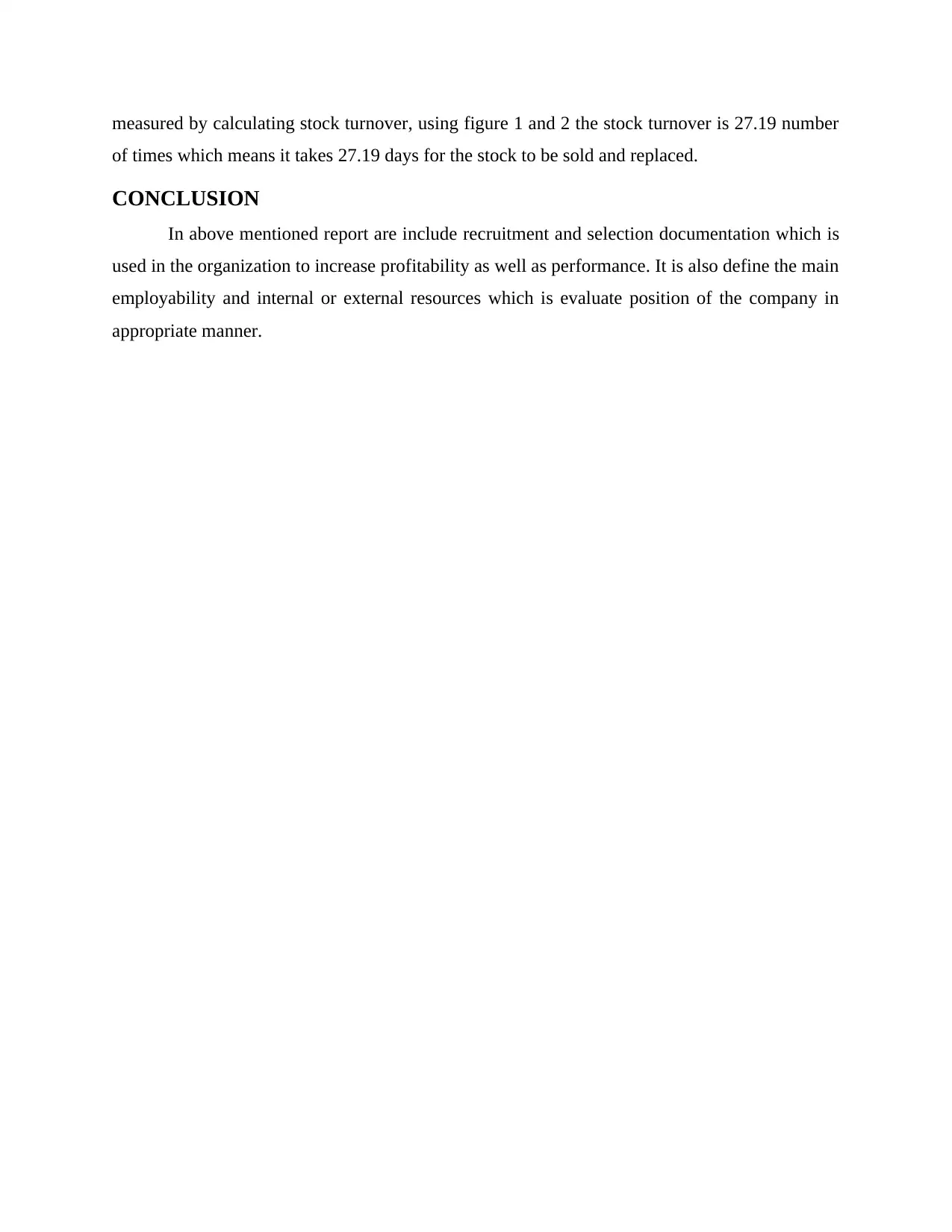
measured by calculating stock turnover, using figure 1 and 2 the stock turnover is 27.19 number
of times which means it takes 27.19 days for the stock to be sold and replaced.
CONCLUSION
In above mentioned report are include recruitment and selection documentation which is
used in the organization to increase profitability as well as performance. It is also define the main
employability and internal or external resources which is evaluate position of the company in
appropriate manner.
of times which means it takes 27.19 days for the stock to be sold and replaced.
CONCLUSION
In above mentioned report are include recruitment and selection documentation which is
used in the organization to increase profitability as well as performance. It is also define the main
employability and internal or external resources which is evaluate position of the company in
appropriate manner.
⊘ This is a preview!⊘
Do you want full access?
Subscribe today to unlock all pages.

Trusted by 1+ million students worldwide
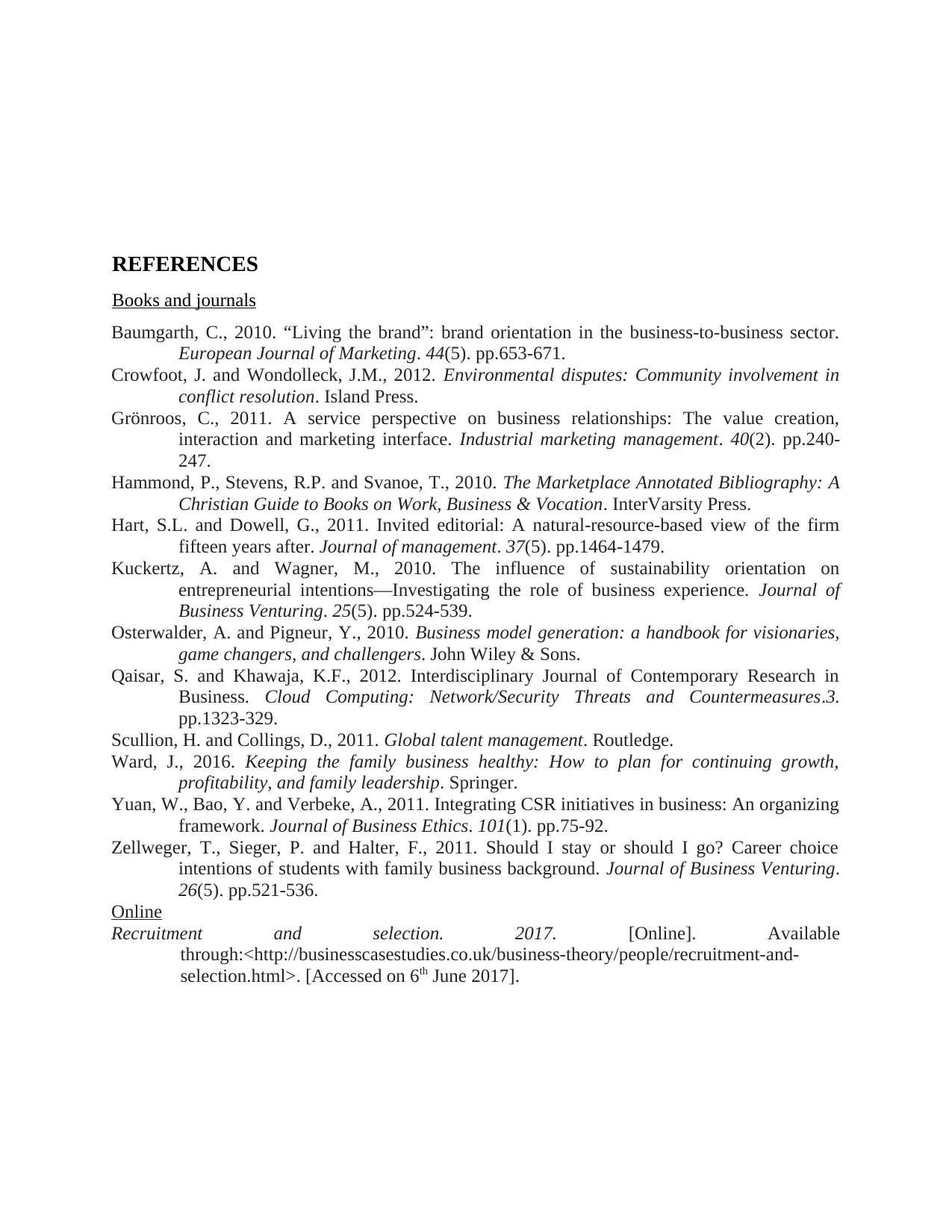
REFERENCES
Books and journals
Baumgarth, C., 2010. “Living the brand”: brand orientation in the business-to-business sector.
European Journal of Marketing. 44(5). pp.653-671.
Crowfoot, J. and Wondolleck, J.M., 2012. Environmental disputes: Community involvement in
conflict resolution. Island Press.
Grönroos, C., 2011. A service perspective on business relationships: The value creation,
interaction and marketing interface. Industrial marketing management. 40(2). pp.240-
247.
Hammond, P., Stevens, R.P. and Svanoe, T., 2010. The Marketplace Annotated Bibliography: A
Christian Guide to Books on Work, Business & Vocation. InterVarsity Press.
Hart, S.L. and Dowell, G., 2011. Invited editorial: A natural-resource-based view of the firm
fifteen years after. Journal of management. 37(5). pp.1464-1479.
Kuckertz, A. and Wagner, M., 2010. The influence of sustainability orientation on
entrepreneurial intentions—Investigating the role of business experience. Journal of
Business Venturing. 25(5). pp.524-539.
Osterwalder, A. and Pigneur, Y., 2010. Business model generation: a handbook for visionaries,
game changers, and challengers. John Wiley & Sons.
Qaisar, S. and Khawaja, K.F., 2012. Interdisciplinary Journal of Contemporary Research in
Business. Cloud Computing: Network/Security Threats and Countermeasures.3.
pp.1323-329.
Scullion, H. and Collings, D., 2011. Global talent management. Routledge.
Ward, J., 2016. Keeping the family business healthy: How to plan for continuing growth,
profitability, and family leadership. Springer.
Yuan, W., Bao, Y. and Verbeke, A., 2011. Integrating CSR initiatives in business: An organizing
framework. Journal of Business Ethics. 101(1). pp.75-92.
Zellweger, T., Sieger, P. and Halter, F., 2011. Should I stay or should I go? Career choice
intentions of students with family business background. Journal of Business Venturing.
26(5). pp.521-536.
Online
Recruitment and selection. 2017. [Online]. Available
through:<http://businesscasestudies.co.uk/business-theory/people/recruitment-and-
selection.html>. [Accessed on 6th June 2017].
Books and journals
Baumgarth, C., 2010. “Living the brand”: brand orientation in the business-to-business sector.
European Journal of Marketing. 44(5). pp.653-671.
Crowfoot, J. and Wondolleck, J.M., 2012. Environmental disputes: Community involvement in
conflict resolution. Island Press.
Grönroos, C., 2011. A service perspective on business relationships: The value creation,
interaction and marketing interface. Industrial marketing management. 40(2). pp.240-
247.
Hammond, P., Stevens, R.P. and Svanoe, T., 2010. The Marketplace Annotated Bibliography: A
Christian Guide to Books on Work, Business & Vocation. InterVarsity Press.
Hart, S.L. and Dowell, G., 2011. Invited editorial: A natural-resource-based view of the firm
fifteen years after. Journal of management. 37(5). pp.1464-1479.
Kuckertz, A. and Wagner, M., 2010. The influence of sustainability orientation on
entrepreneurial intentions—Investigating the role of business experience. Journal of
Business Venturing. 25(5). pp.524-539.
Osterwalder, A. and Pigneur, Y., 2010. Business model generation: a handbook for visionaries,
game changers, and challengers. John Wiley & Sons.
Qaisar, S. and Khawaja, K.F., 2012. Interdisciplinary Journal of Contemporary Research in
Business. Cloud Computing: Network/Security Threats and Countermeasures.3.
pp.1323-329.
Scullion, H. and Collings, D., 2011. Global talent management. Routledge.
Ward, J., 2016. Keeping the family business healthy: How to plan for continuing growth,
profitability, and family leadership. Springer.
Yuan, W., Bao, Y. and Verbeke, A., 2011. Integrating CSR initiatives in business: An organizing
framework. Journal of Business Ethics. 101(1). pp.75-92.
Zellweger, T., Sieger, P. and Halter, F., 2011. Should I stay or should I go? Career choice
intentions of students with family business background. Journal of Business Venturing.
26(5). pp.521-536.
Online
Recruitment and selection. 2017. [Online]. Available
through:<http://businesscasestudies.co.uk/business-theory/people/recruitment-and-
selection.html>. [Accessed on 6th June 2017].
1 out of 10
Related Documents
Your All-in-One AI-Powered Toolkit for Academic Success.
+13062052269
info@desklib.com
Available 24*7 on WhatsApp / Email
![[object Object]](/_next/static/media/star-bottom.7253800d.svg)
Unlock your academic potential
Copyright © 2020–2025 A2Z Services. All Rights Reserved. Developed and managed by ZUCOL.





